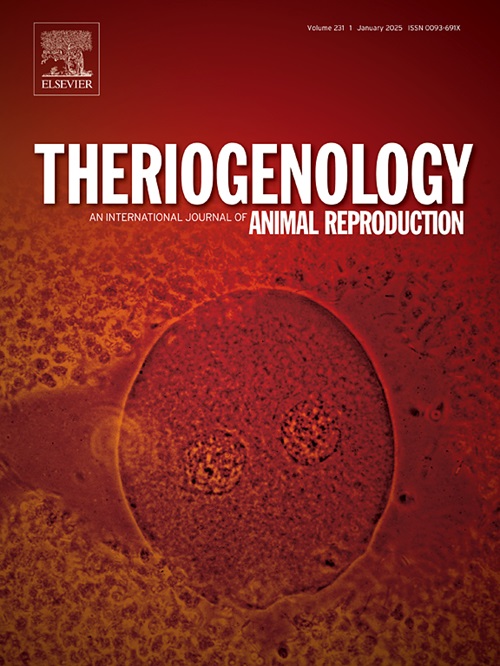补充FGF2、LIF、IGF1对体外源性胚胎移植后妊娠成功的影响
IF 2.4
2区 农林科学
Q3 REPRODUCTIVE BIOLOGY
引用次数: 0
摘要
培养修饰是提高体外来源胚胎能力的一种合乎逻辑的方法。以前,在培养基中添加生长因子FGF2, LIF和IGF1,称为FLI,可以改善冷冻后牛胚胎的发育和存活。在第15天,FLI处理或不处理的胚胎在表型上相似,但转录组学分析显示,与受孕和胎盘发育以及母胚串扰相关的功能存在差异。本研究的目的是研究FLI如何影响慢速冷冻后牛胚胎建立妊娠的能力。胚胎在体外产生,并在有或没有FLI的情况下培养到囊胚期。质量等级为1(6-1或5-1)的胚胎采用慢速冷冻保存。将单个冻融胚胎移植到同步受体女性(n = 192)。于第7天、第19天、第20天、第24天采血,第28天经直肠超声诊断妊娠。该实验在三个地点进行,每个ET的妊娠在所有地点的两组之间相似(P = 0.3)。黄体酮在第7、19、24天和第19、20天的干扰素刺激基因(ISG15、MX2、OAS1)表达在两种处理中相似(P >;0.05)。FLI胚胎受体中PAGs循环浓度升高(P = 0.0061),表明胎盘发育较早,30天后胎盘存活率可能有所提高。在这些研究中没有发现补充FLI对早期胚胎发育的不利影响,因此,它是牛体外胚胎生产系统中有希望的添加物。本文章由计算机程序翻译,如有差异,请以英文原文为准。
Effect of FGF2, LIF, IGF1 supplementation on pregnancy success following embryo transfer of in vitro derived embryos
Culture modifications are a logical approach for improving in vitro-derived embryo competence. Previously, the addition of the growth factors FGF2, LIF, and IGF1, termed FLI, to the culture medium improved bovine embryo development and survival following freezing. At Day 15, embryos treated with or without FLI appeared phenotypically similar, but transcriptomic analysis revealed differences in functions related to conceptus and placental development as well as maternal-embryo crosstalk. The objective of this study was to investigate how FLI influences the ability of a bovine embryo to establish pregnancy following slow-rate freezing. Embryos were produced in vitro and cultured to the blastocyst stage with or without FLI. Embryos with a quality grade of 1 (6–1 or 5–1) were cryopreserved by slow-rate freezing. A single frozen-thawed embryo was transferred to synchronized recipient females (n = 192). Blood samples were collected on Days 7, 19, 20, and 24 and pregnancy diagnosis was performed using transrectal ultrasonography after Day 28. This experiment was carried out across three locations and pregnancies per ET were similar between both groups at all locations (P = 0.3). Progesterone on days 7, 19, and 24, and day 19 and 20 interferon-stimulated genes (ISG15, MX2, OAS1) expression were similar among both treatments (P > 0.05). There were increased (P = 0.0061) circulating concentrations of PAGs in recipients receiving FLI embryos suggesting advanced placental development and possible improvements in viability beyond day 30. No adverse effects of FLI supplementation on early embryo development were detected in these studies, thus, this is a promising addition to bovine in vitro embryo production systems.
求助全文
通过发布文献求助,成功后即可免费获取论文全文。
去求助
来源期刊

Theriogenology
农林科学-生殖生物学
CiteScore
5.50
自引率
14.30%
发文量
387
审稿时长
72 days
期刊介绍:
Theriogenology provides an international forum for researchers, clinicians, and industry professionals in animal reproductive biology. This acclaimed journal publishes articles on a wide range of topics in reproductive and developmental biology, of domestic mammal, avian, and aquatic species as well as wild species which are the object of veterinary care in research or conservation programs.
 求助内容:
求助内容: 应助结果提醒方式:
应助结果提醒方式:


